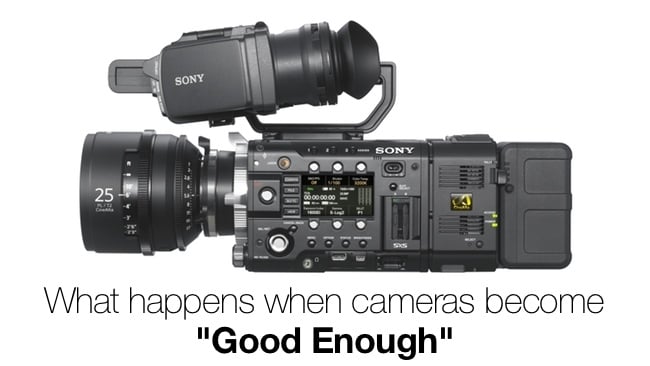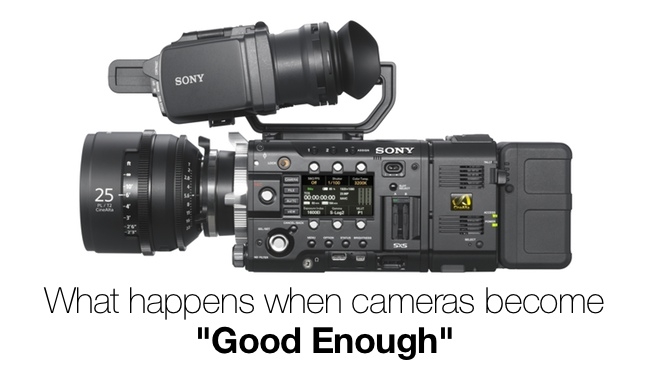
 The Future of Film Equipment Development
The Future of Film Equipment Development
Phil Rhodes wonders what happens now that the best digital camera costs less than the best film camera ever did.
Read part one, by David Shapton, here
One day, the numbers race has to end. HD was a clear and easily understood upgrade from standard definition TV. 4K is a less obvious benefit to many. 8K is met with anything from skepticism to outright derision. Notwithstanding the caution expressed by some people (particularly those faced with the technical realities of getting two-thousand-line pictures from the producer to the audience), more resolution is even harder to argue with than, say, stereo 3D ever was.
There might be more tempting upgrades available. Even if you don't like 4K (or Ultra HD, or Quad HD, call it what you will), there's the expanded colour gamut of the ITU Rec. 2020 standard that often goes with it. ITU Rec. 2020 raises at least the theoretical possibility that one day, broadcast television will have the same access to (among other things) deep green and turquoise colours as photochemical film or some of the better digital cinema cameras.
One might, I suppose, cautiously agree that the expanded colour space is something that might be hard to sell to audiences, in much the same way that 4K on a 30-inch display doesn't really punch you in the visual cortex when viewed from more than a very few feet away. But even if you're not happy with any of this, there's genuinely spectacular, immediately-apparent improvement in things like Dolby's Vision scheme for extremely high dynamic range, which is so obviously a massive upgrade on the status quo that it should be easy to sell even to entirely nontechnical people.
Marching to the Wall
But ultimately, there is a brick wall in the way, whether that's sooner or later. Technology begets better technology, and since the middle of the 20th century it's been predicted that we would establish a situation where we're not really that bounded by technology anymore. We might not quite be living in a post-scarcity society yet, but right now we have 4K and 8K cameras and we could build even more if we wanted to. The very best digital cameras are already cheaper than the best 35mm film cameras were, at the top of their game. In a world where more and more people are watching tablet and smartphone video, though, and many people haven't even got to HD yet, it's a dubious concept at best. Nobody's seriously talking about there being any necessity for resolutions beyond 8K.
It's worth a brief technical digression to make it clear that sensors with high photosite counts are certainly useful in other ways. There may not be a reason to distribute beyond-HD resolutions. There are, however, certainly reasons to acquire it, for all the benefits in downsampling (which we've discussed before), reframing, visual effects, selectivity in grading, improved viewfinding and perceptibility of precision focus, and potentially lower noise, depending on the details of comparative sensor performance. One of the most common complaints of film-experienced camera operators was the lack of 'look-around' on electronic viewfinders – the ability to look outside the picture area that would be recorded to check the position of undesirable elements such as a microphone boom. This was difficult to offer on early digital cameras which needed every photosite they could possibly muster in order to achieve the necessary sharpness. Resolution might not quite be throwaway now, but it's sufficiently easier that cameras such as some versions of Alexa use extra, unrecorded sensor area to provide viewfinder look-around. More photosites are still a useful thing to have.
None of that moves the brick wall, however. At some point, some fairly imminent point, more pixels (and more colours and more dynamic range) will not be enough of a draw to sell cameras and televisions. Whether that's at the 4K or 8K point, or after HDR is widespread, and whether those numbers are associated with acquisition or distribution, there is a threshold of pointlessness that will be clear enough, to enough people, that it just won't work commercially anymore.
In some markets, this has already happened. Small HD newsgathering cameras have been battling it out over the feature set for some time. Our recent review of Sony's PXW-X180 revealed an absolute shopping list of features, an embarrassment of riches, because that's what it takes to differentiate a camera in that market. Sony has recently divested itself of its television manufacturing arm, very possibly because HD displays are now so commoditised it's barely worth buying a brand name.
Where we're heading
Down this road goes more or less everything in technology, let alone just film and TV, as what's possible (which constantly advances) and what's desirable (which is at least limited in extent) inexorably converge. If we accept that things like true 3D, that is, free-space holograms, are a different artform, and that conventional filmmaking will survive in some form, then the equipment required to do it will become less and less of a critical factor. What effect this will have on the people who make and sell the equipment hardly bears thinking about, but one thing is certain: they won't be able to sell us a new camera every 18 months as they do at the moment, and they also won't be able to charge for it as people charged for 35mm cameras fifteen years ago.
But let's not end on a negative note. Most of us have, at some point, yearned for the days when everything was simple, when television was Betacam SP and cinema was 35mm and one could buy a camera that would last half a career. That's a little disingenuous, since the technology in a film camera is really in the consumable film and the processing chemistry rather than the camera and new film stocks were regularly released during the peak of its popularity. Even so, as we've commented before, the white heat of constant change can be a problem in itself, distracting artists from their art with constant blandishments of new tools. We'll never know what could really have been done with, say, a Viper, because it was only in regular use for a very few years. Perhaps the next generation of film and TV people will be able to master one technology before it's replaced, and that's no bad thing.
Tags: Production


Comments